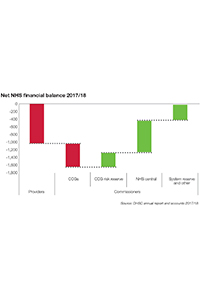NHS in numbers: NHS staff
According to official statistics, there are nearly 1.5 million staff (full-time equivalent) working in the NHS across the four UK health services. Nearly 1.2 million of these work in England, while 139,000, 78,000 and 57,000 work in Scotland, Wales and Northern Ireland respectively.
However, the numbers are not directly comparable as they use some differing definitions. The English figures include GPs and general practice staff in their statistical bulletins, for example, but others do not. Northern Ireland also includes social services staff. 
The 1,190,729 figure for England (or 1,375,388 if you prefer headcount) does not include support organisations and central bodies, which add a further 36,646 staff to the FTE total. The vast majority of staff (1,100,929) work within hospital and community health services (HCHS), while just over 126,000 staff work within general practice.
Within these English totals, there are just over 143,000 doctors, 76% of whom work in HCHS while 24% are GPs.
There are just over 323,000 nurses, health visitors and midwives in England, including nearly 16,000 GP practice nurses. Some 318,000 staff work in roles supporting clinical staff, while a further 168,000 are classed as infrastructure support, including central functions such as finance and property and estates functions.
Overall numbers increased in England by nearly 20,000 in the 12 months to March 2018 – an increase of 1.6%. Within this figure, the total number of doctors increased by nearly 2,700 or 1.9%. Meanwhile, nurse and health visitor numbers fell by 0.1% over the year, while midwife numbers grew by 0.9%.
Across trusts and foundation trusts, NHS Improvement’s quarter 2 report for 2018/19 says there are currently 103,000 vacancies including 41,000 nursing vacancies and 9,300 medical vacancies. In both cases, between 80% and 85% are being filled with either bank or agency staff.
A report from The King’s Fund, The Health Foundation and the Nuffield Trust in November suggested that the staffing shortage could reach 250,000 by 2030.
The report added that if the emerging trend of staff leaving the workforce early continues and the pipeline of newly trained staff and international recruits does not rise sufficiently, this number could be more than 350,000. The current shortages have also increased reliance on temporary staff.
There have been major efforts to bring down the costs of agency staff in recent years – both reducing agency rates and by using bank staff as a preference where the posts cannot be filled substantively.
Costs have decreased since the introduction of controls and rate caps – with costs now falling from more than 7% of the overall pay bill to below 5% now and forecast to fall to 4% by the end of this financial year.
However, rising demand continues to challenge local health economies, with higher than planned activity often requiring increased use of temporary staff.
|
|
All staff |
Medical |
Nursing and midwifery |
|
England |
1,190,729 |
109,346 |
307,535 |
|
Scotland |
139,095 |
12,404 |
43,838 |
|
Wales |
77,917 |
6,321 |
29,524 |
|
Northern |
56,553 |
4,017 |
14,984 |
|
All UK |
1,464,294 |
|
|
Source: NHS Digital, March 2018; Scotland Information Services Division, June 2018: Wales Statistics for Wales 2017; Northern Ireland NISRA June 2018
Related content
The Institute’s annual costing conference provides the NHS with the latest developments and guidance in NHS costing.
The value masterclass shares examples of organisations and systems that have pursued a value-driven approach and the results they have achieved.